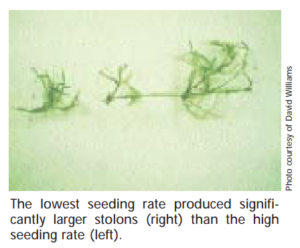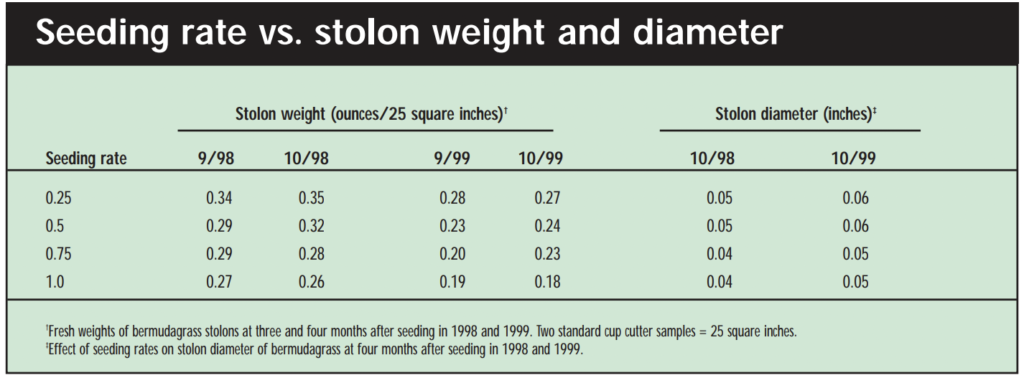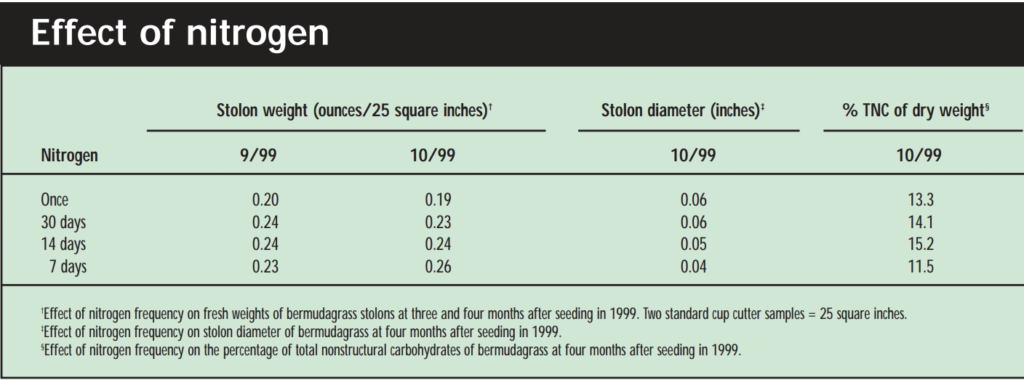Fertilizing with lower levels of nitrogen in the establishment year may enhance stolon production and improve winter hardiness in seeded bermudagrass in the transition zone.
Gregg C. Munshaw and David W. Williams, Ph.D.
Common bermudagrass (Cynodon dactylon L.) on golf courses has traditionally been limited to the southern United States. Within the past few years many seeded varieties that have better color, texture, growth habit and winter hardiness have become available for turf use in the transition zone.
A common concern with warmseason turfgrasses — particularly seeded bermudagrass varieties the first winter after establishment — is a lack of winter hardiness, which can result in winterkill. Generally, after surviving the first winter, seeded bermudagrass stands seem to be able to withstand average winter temperatures across the transition zone (1,7).
Stolons have been found to be an important factor in winter survival (3), and they may be an energy source for spring regrowth, as well as a source of viable buds. The more stolons, the better the chance the stand will survive the winter (3).
Carbohydrate levels in vegetative parts of bermudagrass plants are thought to affect the ability of the plant to withstand cold temperatures. The higher the carbohydrate reserves entering the winter, the greater the chance for plant survival. In bermudagrass, cold tolerance may be reduced if the plant is not able to accumulate sufficient carbohydrate levels (2).

Soluble carbohydrate reserves not used for plant support, or total nonstructural carbohydrates (TNC), are accumulated in organs such as stolons and supply energy to the plant in times of low photosynthetic activity (5).
Little information is available on the appropriate seeding and fertility rates for the new seeded bermudagrass varieties. While looking at fertility rates, some researchers have found that bermudagrass plants receiving only nitrogen were least resistant to cold temperatures (4). Others have found that carbohydrate reserves in buffalograss (Buchloë dactyloides Nutt.) decreased as nitrogen rates increased and that stolons contained the highest levels of carbohydrate reserves of all plant parts (6).
Our research
Our research was designed to examine the effects of four seeding rates and four nitrogen treatments on the production of stolons with the highest possible carbohydrate levels to maximize survival through the first winter. The results of this research could assist turfgrass managers across the transition zone and beyond by establishing management practices that could maximize winter survival by optimizing seeding and nitrogen rates.
Methods
The test site at the University of Kentucky Turfgrass Research Center in Lexington, Ky., was fumigated with methyl bromide before seeding. Plots were established the second week of June 1998 and 1999 using Mirage bermudagrass. Seeding rates of pure live seed were 0.25, 0.50, 0.75 and 1.0 pound/1,000 square feet. Nitrogen was applied by hand in the form of urea (46- 0-0) at establishment and then every seven, 14 or 30 days at 1.0 pound nitrogen/1,000 square feet for the duration of the growing season ending the first of September. This resulted in respective total nitrogen applications of 1, 4, 8 and 12 pounds of nitrogen/1,000 square feet each growing season. Plots were mowed three times per week at 0.75 inch. Visual ratings included percent cover during the growing season and periodic evaluations of turfgrass quality and color. In September and October, samples were removed from the plots with a standard 4-inch-diameter cup cutter, and stolons were removed from the plugs. Weights and diameters of the stolons were determined. In 1999, additional samples were collected immediately after plots entered dormancy and were used for carbohydrate analysis.
Results
1998
Percent cover ratings showed that the low seeding rate was much slower to reach full cover. Two weeks after establishment, plots seeded at the three higher rates had approximately 80 percent cover, whereas those seeded at the low rate had only 50 percent. By the end of the growing season, seeding rate had caused no differences in percent cover. Responses to nitrogen in 1998 were rare, as the soil at the test site is naturally high in nitrogen. By the end of the 1998 growing season, effects of nitrogen were evident. Color rated in September showed significant differences. On the first observation date, Sept. 4, the plots that received nitrogen once every seven or 14 days had significantly darker green color than plots that had received nitrogen only at establishment.

Plots receiving nitrogen every 30 days were not significantly different from any other treatment. On the second observation date, Sept. 11, plots receiving nitrogen at seven-, 14- and 30- day frequencies had significantly darker green color than plots receiving nitrogen only at the time of establishment.
Fresh weights of stolons were determined in September and October. In September, plots seeded at the low rate (0.25 pound/1,000 square feet) produced significantly more stolons than all other seeding rates. In October, the low seeding rate had significantly higher fresh weight than the high seeding rate (1.0 lb/1,000 square feet), but the low rate and the two intermediate rates did not differ. Again, stolon weight did not differ among any of the nitrogen treatments in both months.
Stolon diameter was measured in October. Stolons produced at the low seeding rate had a significantly larger diameter than stolons produced at the low rate, but stolon diameter was not significantly different between the low seeding rate and the two intermediate rates. Frequencies of nitrogen application did not affect stolon diameter.
Green-up was rated on April 20 and 30, 1999 for plots established in 1998. On April 20, plots seeded at the low rates (0.25 and 0.5 pounds/1,000 square feet) had significantly more plants breaking dormancy than did those at the higher rates. The same was true on April 30. On both dates, plots treated with the low February 2002 ■ GCM and high nitrogen frequencies had a significantly higher percent green-up than did plots treated at the two intermediate nitrogen frequencies.
1999
Percent cover in 1999 was rated on July 20 and Aug. 13 at six weeks and 10 weeks after establishment. On July 20, the high-seeding-rate treatment had significantly more cover than the plots seeded at 0.5 and 0.25 pound/1,000 square feet. Plots seeded at 1.0 and 0.75 pound/1,000 square feet produced the same percent cover. Cover varied from 93 percent for the high rate to 75 percent cover for the low rate. On Aug. 13, percent cover varied from 86 percent for the 0.5 pound/1,000 square feet rate to 96 percent for the 0.75 pound/1,000 square feet rate. There were no significant differences among nitrogen treatments for either observation date.
Fresh weights were determined again in September and October 1999. For the September harvest, the low seeding rate produced significantly more stolons than all other rates. In October, the two lower seeding rates produced significantly more stolons than the high rate. The October nitrogen results showed that the “once only at establishment” treatment produced significantly fewer stolons than the “once every seven days” treatment. The two intermediate nitrogen frequencies did not differ significantly in stolon weight from the high or low frequencies.

Stolon diameter was measured in October 1999. Diameter for plots at the low seeding rate was not significantly different from that for plots seeded at the two intermediate rates, but stolons were significantly larger in diameter than those for seeded at the high rate. Plots treated with nitrogen once at establishment produced stolons significantly larger than plots treated at 14 and seven days, but not significantly different from stolons produced by plots treated once every 30 days. The percentage of total nonstructural carbohydrate (TNC) levels in stolons did not differ significantly among the seeding rates.
The percentages of TNC of dry weight ranged from 14.3 percent for the 0.75 pound/1,000 square feet rate to 13.1 percent for the 1.0 pound/1,000 square feet rate. There were no significant differences in TNC percentage among the 14, 30 and onceonly nitrogen treatments, but the 14- day (15.2 percent) and 30-day nitrogen treatments had significantly higher percentages than the seven-day frequency (11.5 percent).
Summary
The new seeded bermudagrass varieties have drastically improved, and in most cases, if the seeded bermudagrass turf survives the first winter, subsequent winters are less of a problem. One way of increasing the likelihood of survival is to increase stolon production and TNC levels. Fertilizing with nitrogen once every two or four weeks at 1.0 pounds/1,000 square feet produces significantly more TNC than fertilizing every seven days. Seeding at a rate of 0.25 pound/1,000 square feet produces the greatest amount of stolons in terms of fresh weight and size. If having more and larger stolons means more carbohydrate storage capacity, it seems that seeding at a rate of 0.25 pounds/1,000 square feet and fertilizing every two weeks would maximize carbohydrate levels.
Plots seeded at the low rate (0.25 pound/1,000 square feet) were slower to reach an acceptable level of coverage than all other rates. If the turf must be played on during the establishment year, more seed may be necessary. Plots seeded at 0.50 pound/1,000 square feet rate reached acceptable cover earlier than those at the low rate and were not far behind in stolon production.
